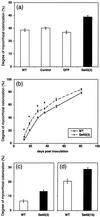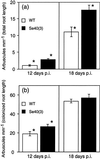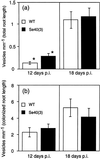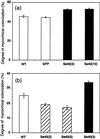Medicago truncatula plants overexpressing the early nodulin gene enod40 exhibit accelerated mycorrhizal colonization and enhanced formation of arbuscules
- PMID: 11752473
- PMCID: PMC65035
- DOI: 10.1073/pnas.251491698
Medicago truncatula plants overexpressing the early nodulin gene enod40 exhibit accelerated mycorrhizal colonization and enhanced formation of arbuscules
Abstract
The mutualistic symbiosis between flowering plants and arbuscular mycorrhizal fungi is extremely abundant in terrestrial ecosystems. In this symbiosis, obligately biotrophic fungi colonize the root of the host plants, which can benefit from these fungi by enhanced access to mineral nutrients in the soil, especially phosphorus. One of the main goals of research on this symbiosis is to find plant genes that control fungal development in the host plant. In this work, we show that mycorrhizal colonization is regulated by enod40, an early nodulin gene known to be involved in the nodule symbiosis of legumes with nitrogen-fixing bacteria. Medicago truncatula plants overexpressing enod40 exhibited stimulated mycorrhizal colonization in comparison with control plants. Overexpression of enod40 promoted fungal growth in the root cortex and increased the frequency of arbuscule formation. Transgenic lines with suppressed levels of enod40 transcripts, likely via a cosuppression phenomenon induced by the transgene, exhibited reduced mycorrhizal colonization. Hence, enod40 might be a plant regulatory gene involved in the control of the mycorrhizal symbiosis.
Figures




Similar articles
-
The endosymbiosis-induced genes ENOD40 and CCS52a are involved in endoparasitic-nematode interactions in Medicago truncatula.Mol Plant Microbe Interact. 2002 Oct;15(10):1008-13. doi: 10.1094/MPMI.2002.15.10.1008. Mol Plant Microbe Interact. 2002. PMID: 12437298
-
Medicago truncatula ENOD11: a novel RPRP-encoding early nodulin gene expressed during mycorrhization in arbuscule-containing cells.Mol Plant Microbe Interact. 2001 Jun;14(6):737-48. doi: 10.1094/MPMI.2001.14.6.737. Mol Plant Microbe Interact. 2001. PMID: 11386369
-
Microtubule organization in root cells of Medicago truncatula during development of an arbuscular mycorrhizal symbiosis with Glomus versiforme.Protoplasma. 2001;217(4):154-65. doi: 10.1007/BF01283396. Protoplasma. 2001. PMID: 11732307
-
[Advances in mechanisms of nutrient exchange between mycorrhizal fungi and host plants].Ying Yong Sheng Tai Xue Bao. 2019 Oct;30(10):3596-3604. doi: 10.13287/j.1001-9332.201910.034. Ying Yong Sheng Tai Xue Bao. 2019. PMID: 31621248 Review. Chinese.
-
The role of mycorrhizal associations in plant potassium nutrition.Front Plant Sci. 2014 Jul 17;5:337. doi: 10.3389/fpls.2014.00337. eCollection 2014. Front Plant Sci. 2014. PMID: 25101097 Free PMC article. Review.
Cited by
-
Impact of endochitinase-transformed white spruce on soil fungal biomass and ectendomycorrhizal symbiosis.Appl Environ Microbiol. 2010 Apr;76(8):2607-14. doi: 10.1128/AEM.02807-09. Epub 2010 Feb 19. Appl Environ Microbiol. 2010. PMID: 20173071 Free PMC article.
-
Biological Activity of Artificial Plant Peptides Corresponding to the Translational Products of Small ORFs in Primary miRNAs and Other Long "Non-Coding" RNAs.Plants (Basel). 2024 Apr 18;13(8):1137. doi: 10.3390/plants13081137. Plants (Basel). 2024. PMID: 38674546 Free PMC article. Review.
-
The Small Key to the Treasure Chest: Endogenous Plant Peptides Involved in Symbiotic Interactions.Plants (Basel). 2025 Jan 26;14(3):378. doi: 10.3390/plants14030378. Plants (Basel). 2025. PMID: 39942939 Free PMC article. Review.
-
Identification of mycorrhiza-regulated genes with arbuscule development-related expression profile.Plant Mol Biol. 2004 Jul;55(4):553-66. doi: 10.1007/s11103-004-1303-y. Plant Mol Biol. 2004. PMID: 15604700
-
Conserved structured domains in plant non-coding RNA enod40, their evolution and recruitment of sequences from transposable elements.NAR Genom Bioinform. 2023 Oct 16;5(4):lqad091. doi: 10.1093/nargab/lqad091. eCollection 2023 Dec. NAR Genom Bioinform. 2023. PMID: 37850034 Free PMC article.
References
Publication types
MeSH terms
Substances
LinkOut - more resources
Full Text Sources
Medical

